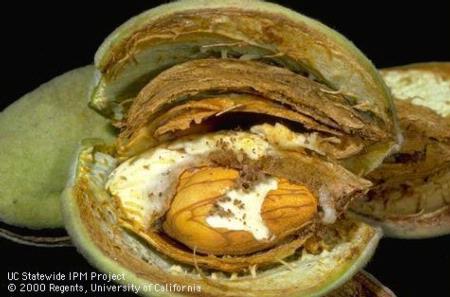
Orchard Sanitation is Critical This Season To Lower NOW Numbers
By Patrick Cavanaugh, Farm News Director
Emily Symmes is the area Integrated Pest Management farm advisor for the Sacramento Valley in the statewide IPM program. She recently spoke to California Ag Today about the high level of Navel Orangeworm (NOW) damage in nut orchards throughout California this past season.
“We had a lot of unique circumstances. The amount of rainfall we got in late 2016 into 2017 was pretty unprecedented and really led us into a really bad navel orangeworm year because we couldn’t get out and sanitize our nut crops,” she said.
“NOW is ubiquitous, and there is an increased nut crop footprint in California, with more than one million acres of almonds, plus pistachios and walnuts,” Symmes explained. “All play host to NOW, as well as a host of natural plants. This thing isn’t going anywhere. And it was pretty bad in 2017 in terms of harvest damage.”
One of the key factors for higher navel orangeworm damage was not being able to get into the fields because of the standing water.
“There were a couple of other factors as well. Typically, rainfall and moist conditions can help NOW mortality in the winter. We tend to think that it can help rot the nuts and do us some favors, but we have to be able to get out and get the nuts shaken or get pulling crews in and get those things on the ground. And then them being on the ground is not always a sure thing. Sanitation was huge in terms of NOW problems this year,” Symmes said.
Heat units also played a part in the development of more NOW pressure. There were a lot of moths flying around longer and laying eggs.
“It got hot in mid to late June, and it seemed to just not let up. What that meant was, in terms of our degree-day models or the heat unit that drive insect development, it ended up getting pretty far out ahead of what is typical, if there is anything such as typical. But certainly ahead of the last couple of years,” Symmes explained.
By September, we were about two weeks ahead in degree-days and that means that the moths were out earlier. They’re flying around. They’re laying eggs on the nuts when they’re still on the trees.
Symmes stressed that the importance of sanitation is to minimize the site where the NOWs mature.
“It’s really important to remember that sanitation efforts aren’t just directly killing any worms that are over-wintering in your orchard. Yes, it does that. But it also minimizes those sites where your first and second generations are going to develop next year,” she said.









